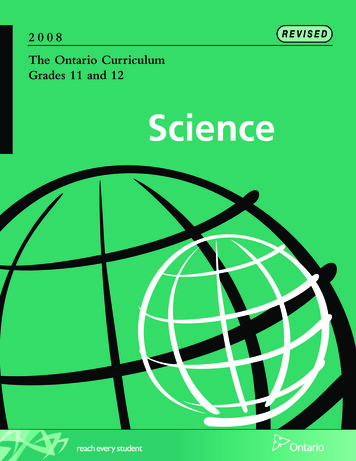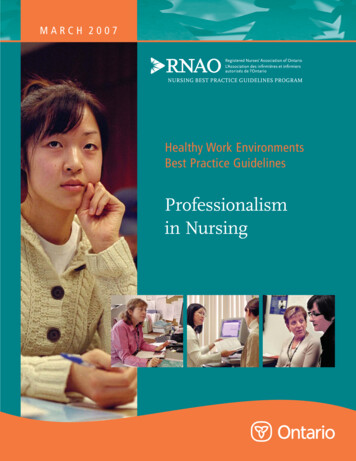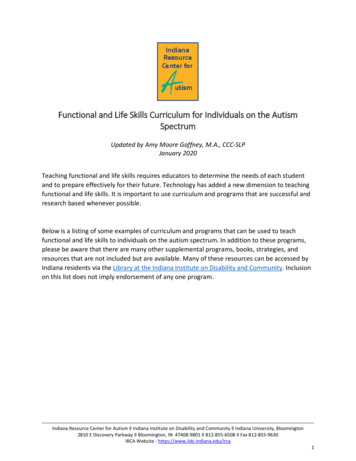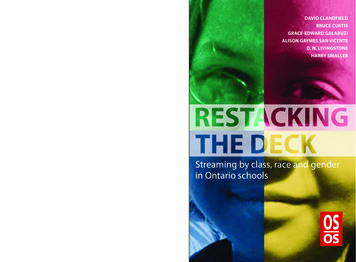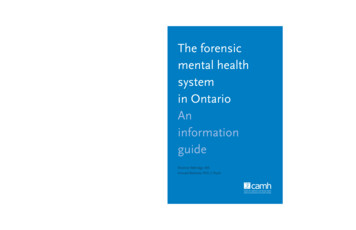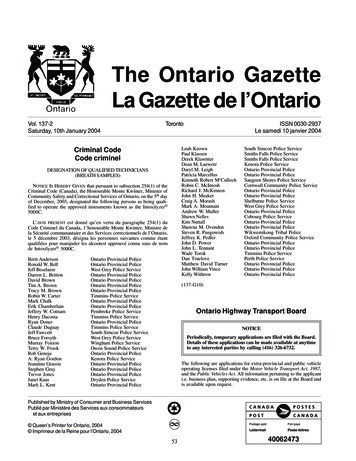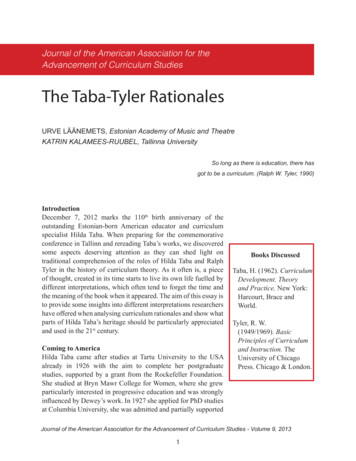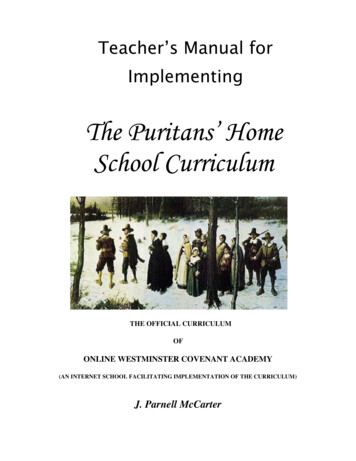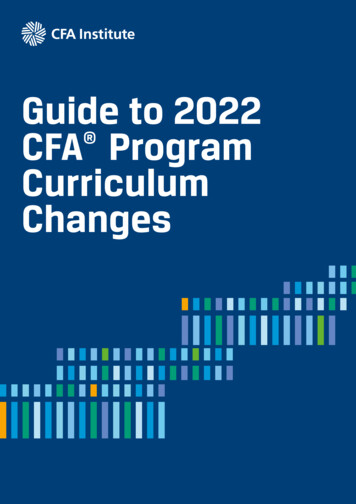
Transcription
Ministry of EducationThe Ontario CurriculumGrades 11 and 12Science2000
ContentsIntroduction . . . . . . . . . . . . . . . . . . . . . . . . . . . . . . . . . . . . . . . . . . . . . . . . . . . . . . . .The Place of Science in the Curriculum . . . . . . . . . . . . . . . . . . . . . . . . . . . . . . . . . . . .33The Program in Science . . . . . . . . . . . . . . . . . . . . . . . . . . . . . . . . . . . . . . . . . . . . . . .Overview . . . . . . . . . . . . . . . . . . . . . . . . . . . . . . . . . . . . . . . . . . . . . . . . . . . . . . . . .Teaching Approaches . . . . . . . . . . . . . . . . . . . . . . . . . . . . . . . . . . . . . . . . . . . . . . . . . .Curriculum Expectations . . . . . . . . . . . . . . . . . . . . . . . . . . . . . . . . . . . . . . . . . . . . . .Strands . . . . . . . . . . . . . . . . . . . . . . . . . . . . . . . . . . . . . . . . . . . . . . . . . . . . . . . . . . . .668910Biology . . . . . . . . . . . . . . . . . . . . . . . . . . . . . . . . . . . . . . . . . . . . . . . . . . . . . . . . . . .Biology, Grade 11, University Preparation (SBI3U) . . . . . . . . . . . . . . . . . . . . . . . . . . . .Biology, Grade 11, College Preparation (SBI3C) . . . . . . . . . . . . . . . . . . . . . . . . . . . . . .Biology, Grade 12, University Preparation (SBI4U) . . . . . . . . . . . . . . . . . . . . . . . . . . . .11122333Chemistry . . . . . . . . . . . . . . . . . . . . . . . . . . . . . . . . . . . . . . . . . . . . . . . . . . . . . . . . .Chemistry, Grade 11, University Preparation (SCH3U) . . . . . . . . . . . . . . . . . . . . . . . . .Chemistry, Grade 12, University Preparation (SCH4U) . . . . . . . . . . . . . . . . . . . . . . . .Chemistry, Grade 12, College Preparation (SCH4C) . . . . . . . . . . . . . . . . . . . . . . . . . . .44455566Earth and Space Science . . . . . . . . . . . . . . . . . . . . . . . . . . . . . . . . . . . . . . . . . . . . . .Earth and Space Science, Grade 12, University Preparation (SES4U) . . . . . . . . . . . . . . .7677Physics . . . . . . . . . . . . . . . . . . . . . . . . . . . . . . . . . . . . . . . . . . . . . . . . . . . . . . . . . . . 88Physics, Grade 11, University Preparation (SPH3U) . . . . . . . . . . . . . . . . . . . . . . . . . . . 89Physics, Grade 12, University Preparation (SPH4U) . . . . . . . . . . . . . . . . . . . . . . . . . . . 101Physics, Grade 12, College Preparation (SPH4C) . . . . . . . . . . . . . . . . . . . . . . . . . . . . . 113Science . . . . . . . . . . . . . . . . . . . . . . . . . . . . . . . . . . . . . . . . . . . . . . . . . . . . . . . . . . .Science, Grade 11, University/College Preparation (SNC3M) . . . . . . . . . . . . . . . . . . . .Science, Grade 11,Workplace Preparation (SNC3E) . . . . . . . . . . . . . . . . . . . . . . . . . . .Science, Grade 12, University/College Preparation (SNC4M) . . . . . . . . . . . . . . . . . . .Science, Grade 12,Workplace Preparation (SNC4E) . . . . . . . . . . . . . . . . . . . . . . . . . . .124125136146157Some Considerations for Program Planning in Science . . . . . . . . . . . . . . . . . . . . . . . 169The Achievement Chart for Science . . . . . . . . . . . . . . . . . . . . . . . . . . . . . . . . . . . . . . 172Une publication équivalente est disponible en français sous letitre suivant : Le curriculum de l’Ontario, 11 e et 12 e année –Sciences, 2000.This publication is available on the Ministry of Education’swebsite at http://www.edu.gov.on.ca.
3IntroductionThe Ontario Curriculum, Grades 11 and 12: Science, 2000 will be implemented in Ontario secondary schools starting in September 2001 for students in Grade 11 and in September 2002for students in Grade 12. This document replaces the parts of the following curriculumguidelines that relate to the senior grades:– Science, Part 1: Program Outline and Policy, Intermediate and Senior Divisions, 1987– Science, Part 6: Science, Grades 11 and 12, Basic Level, Intermediate and Senior Divisions, 1988– Science, Part 7: Environmental Science, Grades 10 to 12, General Level, Intermediate and SeniorDivisions, 1988– Science, Part 8: Environmental Science, Grades 10 and 12,Advanced Level, Intermediate and SeniorDivisions, 1988– Science, Part 9: Applied Biology and Applied Chemistry, Grade 11, General Level, Intermediate andSenior Divisions, 1988– Science, Part 10: Applied Physics and Technological Science, Grade 12, General Level, Intermediateand Senior Divisions, 1989– Science, Part 11: Geology, Grade 12, General and Advanced Levels, Intermediate and SeniorDivisions, 1988– Science, Part 12: Biology, Grade 11,Advanced Level, and the OAC, Intermediate and SeniorDivisions, 1987– Science, Part 13: Chemistry, Grade 11,Advanced Level, and the OAC, Intermediate and SeniorDivisions, 1987– Science, Part 14: Physics, Grade 12,Advanced Level, and the OAC, Intermediate and SeniorDivisions, 1988– Science, Part 15: Science in Society, OAC, Intermediate and Senior Divisions, 1988This document is designed for use in conjunction with The Ontario Curriculum, Grades 9 to 12:Program Planning and Assessment, 2000, which contains information relevant to all disciplinesrepresented in the curriculum. The planning and assessment document is available both inprint and on the ministry’s website, at http://www.edu.gov.on.ca.The Place of Science in the CurriculumDuring the twentieth century, science has come to play an increasingly important role in thelives of all Canadians. It underpins many of the technologies that we now take for granted,from life-saving pharmaceuticals to computers and other information technologies. There isevery reason to expect that science and its impact on our lives will continue to grow as weenter the twenty-first century. Consequently, scientific literacy for all has become the goal ofscience education throughout the world, and has been given expression in Canada in theCommon Framework of Science Learning Outcomes, K to 12: Pan-Canadian Protocol for Collaborationon School Curriculum (Council of Ministers of Education, Canada, 1997). Scientific literacy canbe defined as possession of the scientific knowledge, skills, and habits of mind required tothrive in the science-based world of the twenty-first century.
4THE ONTARIO CURRICULUM, GRADES 11 AND 12: SCIENCEAchieving excellence in scientific literacy is not the same as becoming a science specialist. Thenotion of thriving in a science-based world applies as much to a small-business person, alawyer, an elementary school teacher, or an office worker as it does to a doctor, an engineer, ora research scientist. While the specific knowledge and skills required for each of these occupations vary, the basic goal of thriving in a science-based world remains the same. Achievementof both excellence and equity underlies the goals of the new science program at the secondarylevel. Accordingly, science courses have been designed for a wide variety of students, takinginto account their interests and possible postsecondary destinations. Some courses have beendesigned to serve as preparation for specialist studies in science-related fields; others have beendesigned for students intending to go on to postsecondary education but not to study science;still others have been designed with the needs of the workplace in mind. The overall intentionis that all graduates of Ontario secondary schools will achieve excellence and a high degree ofscientific literacy while maintaining a sense of wonder about the world around them.Accordingly, the curriculum reflects new developments on the international science scene andis intended to position science education in Ontario at the forefront of science educationaround the world.Science has significant, though varied, connections with many other disciplines. Science isrelated in many ways to the economies of most nations, including Canada, and plays a majorrole in public and private decisions in many areas of society. It is critical, for example, to decisions and developments relating to sustainable development. Thus, science cannot be taught inisolation, but must be linked to other disciplines. Clearly, many topics studied in mathematicsand technological education overlap with topics covered in science. Similar links exist withgeography and other areas of social studies. Communication is, of course, extremely importantin science, as it is in all disciplines – both in terms of reading and writing, and in the use ofinformation technology for collecting, organizing, and presenting information. The neweraspects of the science curriculum – especially those that focus on science, technology, society,and the environment (STSE) – call for students to deal with the impacts of science on societyand the environment, which includes both the natural environment and the workplace environment. This requirement brings in issues that relate to human values. Science can thereforenot be viewed as merely a matter of “facts”; rather, it is a subject in which students learn toweigh the complex combinations of fact and value that developments in science and technology have given rise to in modern society.Subject matter from any course in science can be combined with subject matter from one ormore courses in other disciplines to create an interdisciplinary course. The policies and procedures regarding the development of interdisciplinary courses are outlined in the interdisciplinary studies curriculum policy document.The secondary curriculum in science in Grades 9 to 12 builds on three basic goals that runthrough every grade and strand of the elementary curriculum and that reflect the essentialtriad of knowledge, skills, and the ability to relate science to technology, society, and the environment (STSE). In the secondary program, these goals vary somewhat according to the typeof course, but they are always present in some form and serve to unify the program (seepage 6). Science is approached in all courses not only as an intellectual pursuit but also as anactivity-based enterprise operating within a social context.
INTRODUCTION5The content of the secondary science program also builds on the five strands present in theelementary curriculum, although less emphasis is placed on technological education, which isa distinct discipline at the secondary level. The study of biology, chemistry, earth and space science, and physics in strands in the Grade 9 and 10 courses is expanded to the study of thesesubject areas in full courses in Grades 11 and 12. In addition, the transition between Grade 8and Grade 9 courses and between the courses from Grades 9 to 12 is a smooth one because ofthe close alignment of both the elementary and the secondary program with the pan-CanadianCommon Framework of Science Learning Outcomes.
6The Program in ScienceOverviewThe overall aim of the secondary science program is to ensure scientific literacy for every secondary school graduate. This aim can be achieved by meeting three overall goals for every student. The secondary science program, from Grade 9 through Grade 12, is designed to promotethese goals, which are as follows:– to understand the basic concepts of science– to develop the skills, strategies, and habits of mind required for scientific inquiry– to relate science to technology, society, and the environmentThese three goals are defined more specifically within the courses that make up the scienceprogram. Every strand, or broad curriculum area, of each course has three overall expectationsand three groups of specific expectations that correspond to the three goals. These goals arealso the basis on which student achievement in science is assessed.Four types of courses are offered in the Grade 11 and 12 science program: university preparation,university/college preparation, college preparation, and workplace preparation. (See The OntarioCurriculum, Grades 9 to 12: Program Planning and Assessment, 2000 for a description of the different types of secondary school courses.) A list of all Grade 11 and 12 science courses is givenbelow. A chart showing prerequisites is given on page 8.Courses in Science, Grades 11 and 12Course NameCourse Grade 10 Science, Academic11BiologyCollegeSBI3CGrade 10 Science, Academic or Applied12BiologyUniversitySBI4UGrade 11 Biology, University11ChemistryUniversitySCH3UGrade 10 Science, Academic12ChemistryUniversitySCH4UGrade 11 Chemistry, University12ChemistryCollegeSCH4CGrade 10 Science, Academic or AppliedUniversitySES4UGrade 10 Science, AcademicGradeBiologyChemistryEarth and Space Science12Earth andSpace Science
7THE PROGRAM IN SCIENCECourse NameCourse Grade 10 Science, Academic12PhysicsUniversitySPH4UGrade 11 Physics, University12PhysicsCollegeSPH4CGrade 10 Science, Academic or Applied11ScienceUniversity/CollegeSNC3MGrade 10 Science, Academic or Applied11ScienceWorkplaceSNC3EGrade 9 Science, Academic or Applied12ScienceUniversity/CollegeSNC4MGrade 11 Science, University/College12ScienceWorkplaceSNC4EGrade 11 Science, WorkplaceGradePhysicsScienceNote: Each of the courses listed above is worth one credit.A Note About Credits. Courses in Grades 11 and 12 are designed to be offered as full-creditcourses. However, half-credit courses may be developed for specialized programs, such asschool-work transition and apprenticeship programs, as long as the original course is not designated as a requirement for entry into a university program. Individual universities will identify the courses that are prerequisites for admission to specific programs. Such courses must beoffered as full-credit courses, to ensure that students meet admission requirements.In Grades 9 to 12, half-credit courses, which require a minimum of fifty-five hours of scheduled instructional time, must adhere to the following conditions: The two half-credit courses created from a full course must together contain all of theexpectations of the full course, drawn from all of the strands of that course and divided in amanner that best enables students to achieve the required knowledge and skills in theallotted time. A course that is a prerequisite for another course in the secondary curriculum may beoffered as two half-credit courses, but students must successfully complete both parts of thecourse to fulfil the prerequisite. (Students are not required to complete both parts unless thecourse is a prerequisite for another course that they wish to take.) The title of each half-credit course must include the designation Part 1 or Part 2. A halfcredit (0.5) will be recorded in the credit-value column of both the report card and theOntario Student Transcript.Boards will ensure that all half-credit courses comply with the conditions described above, andwill report all half-credit courses to the ministry annually in the School September Report.
8THE ONTARIO CURRICULUM, GRADES 11 AND 12: SCIENCEPrerequisite Chart for Science, Grades 9–12This chart maps out all the courses in the discipline and shows the links between courses and the possible prerequisites for them.It does not attempt to depict all possible movements from course to course.Earth and Space ScienceGrade 12, UniversityScienceGrade 10, AcademicBiologyBiologyGrade 11, UniversityGrade 12, UniversityChemistryChemistryGrade 11, UniversityGrade 12, UniversityPhysicsPhysicsGrade 11, UniversityGrade 12, UniversityScienceScienceGrade 11, University/CollegeGrade 12, University/CollegeScienceGrade 9, AcademicScienceGrade 9, AppliedBiologyGrade 11, CollegeChemistryGrade 12, CollegeScienceGrade 10, AppliedPhysicsGrade 12, CollegeScienceScienceGrade 11, WorkplaceGrade 12, WorkplaceTeaching ApproachesIt is important that students have opportunities to learn in a variety of ways: individually andcooperatively; independently and with teacher direction; through hands-on activities; andthrough the study of examples followed by practice. There is no single correct way to teachor to learn. The nature of the science curriculum calls for a variety of strategies for learning.The strategies should vary according to the curriculum expectations and the needs of thestudents.The expectations in science courses call for an active, experimental approach to learning, andrequire all students to participate regularly in laboratory activities. Laboratory activities canreinforce the learning of scientific concepts and promote the development of the skills of
THE PROGRAM IN SCIENCE9scientific investigation and communication. Where opportunity allows, students might berequired, as part of their laboratory activities, to design and conduct research on a real scientific problem for which the results are unknown.The goal of relating science to technology, society, and the environment (STSE) is an important new feature of this curriculum. In order to attain this goal, connections between scienceand technology and between science and the world beyond the school must be integrated intostudents’ learning of scientific concepts and skills. Where possible, concepts should be introduced in the context of real-world problems and issues.Students should also be provided with a variety of opportunities to broaden their understanding of scientific investigation. They should be encouraged to participate in research field tripsand debates, and should have opportunities to interview people who are knowledgeable inspecific areas of science, such as guest speakers at the school.Curriculum ExpectationsThe expectations identified for each course describe the knowledge and skills that students areexpected to develop and demonstrate in their class work, on tests, and in various other activities on which their achievement is assessed and evaluated.Two sets of expectations are listed for each strand, or broad curriculum area, of each course.The overall expectations describe in general terms the knowledge and skills that students areexpected to demonstrate by the end of each course. The specific expectations describe theexpected knowledge and skills in greater detail.The specific expectations are organized under subheadings. This organization is not meant toimply that the expectations in any one group are achieved independently of the expectationsin the other groups. The subheadings are used merely to help teachers focus on particularaspects of knowledge and skills as they plan learning activities for their students.Many of the expectations are accompanied by examples, given in parentheses. These examplesare meant to illustrate the kind of skill, the specific area of learning, the depth of learning,and/or the level of complexity that the expectation entails. They are intended as a guide forteachers rather than as an exhaustive or mandatory list.In all courses, a list of expectations is given that precedes the strands. These expectationsdescribe skills that are considered to be essential for scientific investigation (e.g., skills inresearch, in the use of materials, and in the use of units of measurement), and skills required forinvestigating possible careers in the subject area. These skills apply to all areas of course content and must be developed in all strands of the course. Teachers should ensure that studentsdevelop these skills in appropriate ways while achieving the curriculum expectations outlinedin the strands. Assessment of students’ mastery of these skills must be included in the evaluationof students’ achievement of the expectations for the course.
10THE ONTARIO CURRICULUM, GRADES 11 AND 12: SCIENCEStrandsThe expectations for the Grade 11 and 12 science courses are organized in five distinct butrelated strands. The strands are different for each course. The content of the strands includes,where possible, topics set out in the pan-Canadian Common Framework of Science LearningOutcomes. The strands for all the Grade 11 and 12 science courses are outlined in the followingchart.CourseStrand 1Strand 2Strand 3Strand 4Strand 5Biology 11 UCellularFunctionsGeneticContinuityInternal Systemsand RegulationDiversity ofLiving ThingsPlants: Anatomy,Growth, andFunctionsBiology 11 CCellular BiologyMicrobiologyAnimal Anatomyand PhysiologyPlant Structure andPhysiologyEnvironmentalScienceBiology 12 UMetabolic ProcessesMolecular GeneticsHomeostasisEvolutionPopulation DynamicsChemistry 11 UMatter andChemical BondingQuantities inSolutions andChemical Reactions SolubilityGases andAtmosphericChemistryHydrocarbons andEnergyChemistry 12 UOrganic ChemistryEnergy Changesand Rates ofReactionChemical Systemsand EquilibriumElectrochemistryStructure andPropertiesChemistry 12 CMatter andQualitative lculationsChemistry in theEnvironmentEarth and SpaceScience 12 UThe Earth As aPlanetIntroduction toEarth SciencesEarth MaterialsInternal andSurficial EarthProcessesEarth HistoryPhysics 11 UForces and MotionEnergy, Work,and PowerWaves and SoundLight and Geometric Electricity andOpticsMagnetismPhysics 12 UForces and Motion:DynamicsEnergy andMomentumElectric,Gravitational,and Magnetic FieldsThe Wave Natureof LightMatter-EnergyInterfacePhysics 12 CMechanical SystemsElectricity andElectronicsHydraulic andPneumatic nsScience 11 U/CEveryday Chemicals Body Input andand Safe PracticeBody FunctionWasteManagementScience and SpaceTechnologies inEveryday LifeScience 11 WMaterials and SafetyElectrical CircuitsMicro-organismsThe ImmuneSystem and HumanHealthHuman Impact onthe EnvironmentScience 12 U/COrganic Productsin Everyday LifePathogens andDiseaseEnergyAlternativesand Global ImpactCommunicationsSystemsScience andContemporarySocietal IssuesScience 12 WChemistry atHome and WorkCommunications:Sounds and ndscaping, andForestryAlternativeEnvironmentsNote: In the above chart, the following abbreviations are used: U for university preparation, U/C for university/college preparation,C for college preparation, and W for workplace preparation.
11Biology
12Biology, Grade 11, University Preparation(SBI3U)This course furthers students’ understanding of the processes involved in biological systems.Students will study cellular functions, genetic continuity, internal systems and regulation, thediversity of living things, and the anatomy, growth, and functions of plants. The course focuseson the theoretical aspects of the topics under study, and helps students refine skills related toscientific investigation.Prerequisite: Science, Grade 10, AcademicThroughout this course, students will: demonstrate an understanding of safety practices consistent with Workplace HazardousMaterials Information System (WHMIS) legislation by selecting and applying appropriatetechniques for handling, storing, and disposing of laboratory materials (e.g., use proper techniques in preparing, using, and disposing of bacterial cultures); select appropriate instruments and use them effectively and accurately in collecting observations and data (e.g., microscope, laboratory glassware, stethoscope, dissection instruments); demonstrate the skills required to plan and carry out investigations, using laboratory equipment safely, effectively, and accurately (e.g., conduct an experiment to determine the effectsof quantity and quality of light on photosynthesis); select and use appropriate numeric, symbolic, graphical, and linguistic modes of representation to communicate scientific ideas, plans, and experimental results (e.g., use characteristicsof organisms and the principles and nomenclature of taxonomy to classify organisms; useproper terminology related to organs and tissues); locate, select, analyse, and integrate information on topics under study, working independentlyand as part of a team, and using appropriate library and electronic research tools, includingInternet sites; compile, organize, and interpret data, using appropriate formats and treatments, includingtables, flow charts, graphs, and diagrams; communicate the procedures and results of investigations and research for specific purposesusing data tables and laboratory reports (e.g., report on an experimental investigation of themovement of materials across a cell membrane); express the result of any calculation involving experimental data to the appropriate numberof decimal places or significant figures; select and use appropriate SI units (units of measurement of the Système international d’unités,or International System of Units); identify and describe science- and technology-based careers related to the subject areaunder study (e.g., biochemist, forester, geneticist, physiotherapist, oncologist, horticulturist).
13BIOLOGY, GRADE 11, UNIVERSITY PREPARATION (SBI3U)Cellular FunctionsOverall ExpectationsBy the end of this course, students will: demonstrate an understanding of cell structure and function and the processes of metabolismand membrane transport; investigate the fundamental molecular principles and mechanisms that govern energytransforming activities in all living matter, whether it be animal, plant, or microbial; demonstrate an understanding of the relationship between cell functions and their technological and environmental applications.Specific ExpectationsUnderstanding Basic ConceptsBy the end of this course, students will:– describe how organelles and other cellcomponents carry out various cellprocesses (e.g., digestion, transportation,gas exchange, excretion) and explain howthese processes are related to the functionof organs;– identify and describe the structure andfunction of important biochemical compounds, including carbohydrates, proteins,lipids, and nucleic acids;– describe the fluid mosaic structure of cellmembranes, and explain the dynamics ofpassive transport (facilitated diffusion) andthe processes of endocytosis and exocytosisof large particles;– explain the flow of energy between photosynthesis and respiration;– compare anaerobic respiration (includingfermentation) and aerobic respiration andstate the advantages and disadvantages foran organism or tissue of using eitherprocess;– illustrate and explain important cellularprocesses (e.g., protein synthesis, respiration, lysosomal digestion), including theirfunction in the cell, the ways in whichthey are interrelated, and the fact that theyoccur in all living cells.Developing Skills of Inquiryand CommunicationBy the end of this course, students will:– design and carry out an investigation oncellular function, controlling the majorvariables (e.g., examine the movement ofsubstances across a membrane; measure ametabolic process such as fermentation);– view and manipulate computer-generated,three-dimensional molecular models ofimportant biochemical compounds,including carbohydrates, proteins, lipids,and nucleic acids;– identify new questions and problemsstemming from the study of metabolism inplant and animal cells (e.g.,What is therelationship between chloroplasts andmitochondria in plant cells?);– carry out, in a safe and accurate manner,biological tests for macromolecules foundin living organisms (e.g., use iodine andBenedict’s solution to test for carbohydrates; use Sudan IV to test for the presence of lipids).
14THE ONTARIO CURRICULUM, GRADES 11 AND 12: SCIENCERelating Science to Technology, Society,and the EnvironmentBy the end of this course, students will:– present informed opinions on advances incellular biology and possible applicationsthrough related technology (e.g., newtreatments for cancer; the possibility ofproducing ethanol as a fuel; the uses ofradioactive labelling, fluorescence ofgenetic material, or simulations of threedimensional molecular structure);– explain how scientific knowledge of cellular processes is used in technological applications (e.g., how knowledge of a particular microbe is used in biotechnologicalapplications in the pulp and paper industry or in the clean-up of oil spills);– analyse ways in which societal needs haveled to technological advances related tocellular processes (e.g., document, usingnewspaper articles, the impact of publicawareness on research to detect and treatdiseases such as AIDS and hepatitis C).
15BIOLOGY, GRADE 11, UNIVERSITY PREPARATION (SBI3U)Genetic ContinuityOverall ExpectationsBy the end of this course, students will: demonstrate an understanding of the necessity of meiosis and describe the importance ofgenes in transmitting hereditary characteristics according to Mendel’s model of inheritance; perform laboratory studies of meiosis and analyse the results of genetic research related tothe laws of heredity; outline the scientific findings and some of the technological advances that led to the modernconcept of the gene and to genetic technology, and demonstrate an awareness of some of thesocial and political issues raised by genetic research and reproductive technology.Specific ExpectationsUnderstanding Basic ConceptsBy the end of this course, students will:– demonstrate an understanding of theprocess and importance of mitosis (e.g.,cell division and the phases of mitosis);– explain how the concepts of DNA, genes,chromosomes, and meiosis account for thetransmission of hereditary characteristicsfrom generation to generation (e.g., explainhow the sex of an individual can be determined genetically; demonstrate an understanding that the expression of a geneticdisorder linked to the sex chromosomes ismore common in males than in females);– describe and explain the process of discovery (e.g., the sequence of studies and theknowledge gained) that led Mendel to formulate his laws of heredity;– explain the process of meiosis in termsof the replication and movement ofchromosomes;– describe genetic disorders (e.g., Down syndrome, cystic fibrosis, muscular dystrophy,fragile X syndrome) in terms of the chromosomes affected, physical effects, andtreatment;– explain, using Mendelian genetics, theconcepts of dominance, co-dominance,incomplete dominance, recessiveness, andsex-linkag
12 Physics University SPH4U Grade 11 Physics, University 12 Physics College SPH4C Grade 10 Science, Academic or Applied Science 11 Science University/College SNC3M Grade 10 Science, Academic or Applied 11 Science Workplace SNC3E Grade 9 Science, Academic or Applied 12 Science University/College SN
